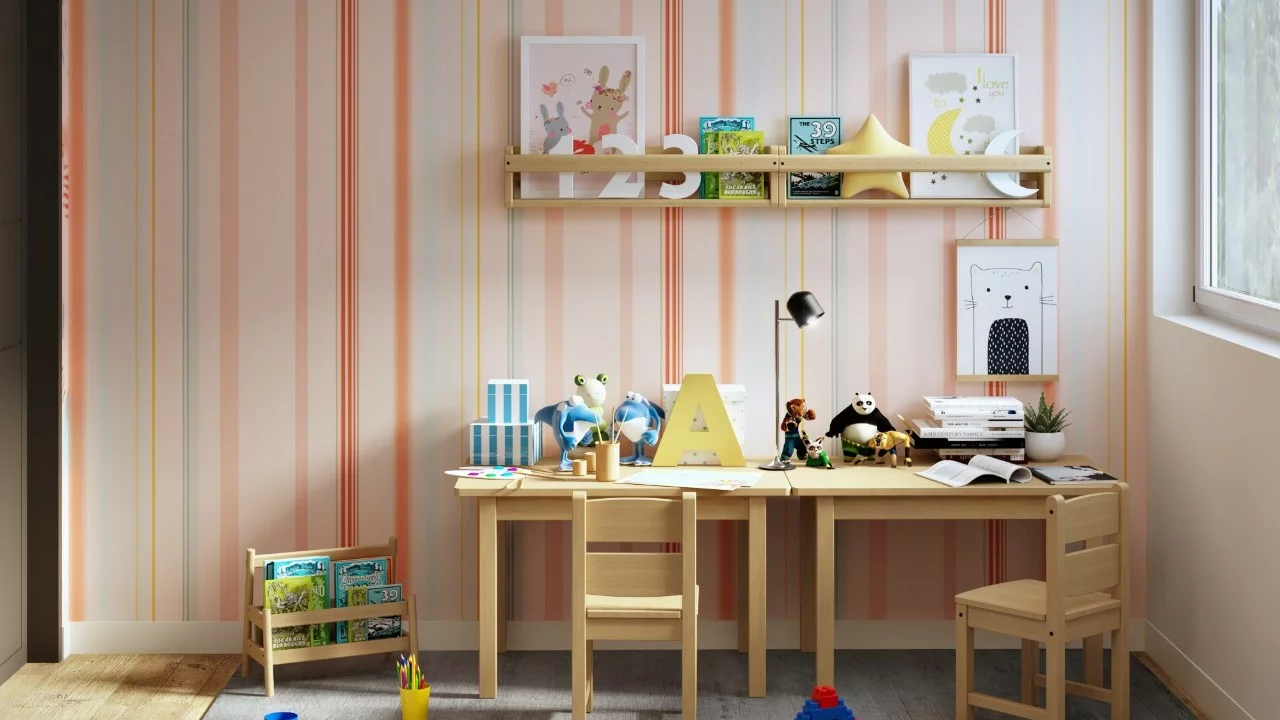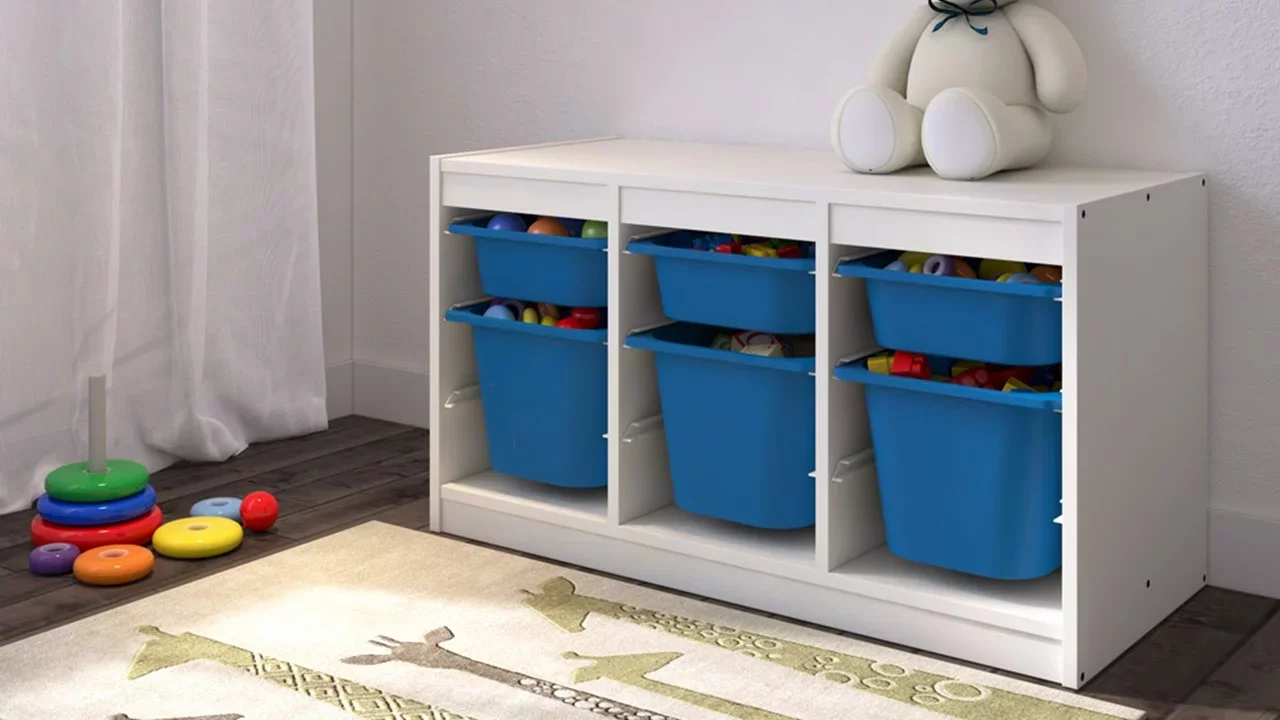
The importance of a child’s bedroom goes beyond aesthetics. This room will be their sanctuary, where they play, rest, and discover the world around them. The appropriate furniture is crucial in this adventure.
For example, a thoughtfully crafted bed serves as more than just a place for slumber – it transforms into a stronghold, a spacecraft, or a royal palace in the realm of their imaginative games. A desk becomes a place for creativity and learning, and shelves filled with books & toys are gateways to new adventures and knowledge.
Your child’s environment can significantly impact their development and creativity in their early years. A thoughtfully furnished room can inspire them, provide comfort, and encourage their growing independence. As you read on, we’ll guide you through choosing pieces that are adorable, practical, safe, and adaptable to the changing needs of your growing child.
3 Essential Furniture Pieces for Kids Bedrooms
1. Beds
- Bunk Beds: Ideal for siblings sharing a room or for sleepovers, bunk beds are a fun and space-efficient solution. When choosing a bunk bed, ensure it has robust guardrails and a secure, steady ladder for safety. Some bunk beds have additional features like storage drawers or a trundle bed underneath.
- Loft Beds: Similar to bunk beds but with a twist – instead of a lower bunk, there’s an open space that can be used for study area, storage, or play space. This is a great option for small rooms. Ensure the bed has secure guardrails and a robust ladder.
- Themed Beds: Themed beds, such as those shaped like cars, boats, or castles, can ignite a child’s imagination. While these are visually appealing, it is essential to ensure that they meet safety standards and are manageable for young children.
2. Desks and Chairs
- Ergonomic Chairs: Choose an adjustable, ergonomic chair to support your child’s posture. The chair should be designed so that your child’s feet rest flat on the floor and their arms are at a comfortable, ergonomic height in relation to the desk.
- Adjustable Desks: Like chairs, desks should grow with your child. Adjustable desks can be modified in height, ensuring they are always at an appropriate level as your child grows. Consider desks with storage options to keep study materials organised.
3. Storage Solutions
- Dressers: A dresser is essential for storing clothes. Choose one with easy-to-pull handles and drawers that glide smoothly. Safety tip: Secure the dresser to the wall to prevent tipping.
- Shelves: Wall shelves or bookcases are perfect for keeping books, toys, and decorative items. They can be placed at a height that is safe and accessible for your child.
- Toy Chests: These help organise toys and keep the room clutter-free. Opt for a chest with a lid that stays open and doesn’t slam shut, to avoid little fingers getting caught.
Maximising Space in Small Bedrooms
Multifunctional Furniture
- Beds with Storage: A bed with built-in storage is a game-changer in small bedrooms. Drawers under the bed can store clothes, linens, or toys – freeing up valuable closet & floor space. Some beds come with shelving in the headboard for books or decorative items.
- Fold-down Desks: This is a smart solution for a study area in a small room. It can be mounted on the wall and folded away when not in use, maximising the available floor space. Look for desks with additional shelves or storage compartments to keep study materials.
- Convertible Furniture: Consider furniture pieces that can serve multiple purposes. For example, a bench with storage can be used as seating and for storing toys or books. Similarly, an ottoman with a lid can double as a storage box and a small table.
Using Vertical Space
- Wall-mounted Shelves: Utilising wall space for storage is an effective way to clear floor clutter. Install shelves above the desk, beside the bed, or in any unused wall space. These can hold books, toys, or decorative items.
- Hanging Organisers: Over-the-door storage solutions or hanging organisers are great for storing small items like toys, art supplies, or accessories. They are easily accessible and keep things organised, without taking up floor space.
- Lofted Beds: These can create significant usable space underneath, if the room height allows. This area can be used for a study desk, a play area, or additional storage.
Other Space-Saving Tips
- Choose Light Colours: Light colours can make a small space feel larger and more open. Consider light hues for walls, bedding, and furniture.
- Mirrors: Adding a mirror can visually expand the space. A mirror reflects light and gives the illusion of a bigger room.
- Under-desk or Under-bed Storage: Utilise bins or baskets for under-desk or under-bed storage. This is a great way to keep seasonal items or less frequently used toys out of sight but easily accessible.
- Sliding Doors: If the room has a closet, consider replacing swing-out doors with sliding doors to save space.
5 Themes for Kids Bedrooms
- Space Odyssey Theme: Use dark, starry wallpaper or paint a solar system mural on one wall. Incorporate bedding & curtains with stars, planets, or astronaut motifs. Accessories like a telescope, glow-in-the-dark ceiling stars, and space-themed lamps can add to the ambience. Furniture that is shaped like rockets and hanging chairs shaped like UFOs can make the room feel like a real space adventure.
- Jungle Safari Theme: Turn the bedroom into a tropical jungle with lush greenery and animal prints. Use wallpapers or decals with images of trees, exotic birds, and wild animals. Incorporate a tent or a treehouse-style bed for an adventurous feel. Animal-themed bedding, a leaf canopy over the bed, and plush animal toys will add to the jungle vibe. Wooden furniture and a green, brown, & yellow palette can complete the look.
- Fairy Tale Princess / Prince Theme: Think of castles, knights, and magical forests for a fairy tale-inspired bedroom. Use pastel colours or a mural of a castle or an enchanted forest. A canopy bed or a bed designed like a carriage can be the room’s focal point. Add decorative elements like crowns, wands, tiaras, plush velvet curtains, and bedding. Wall stickers or paintings of fairy tale characters can bring the theme to life.
- Underwater Adventure Theme: Wallpapers or wall decals featuring ocean scenes, fish, coral, and mermaids can set the scene. A bed with a boat or submarine design can be exciting for a child. Use bedding & curtains with sea creature motifs, and add a fish tank for an authentic touch. Accessories like treasure chest toy boxes and ship wheel décor can enhance the theme.
- Sports Arena Theme: Ideal for young sports enthusiasts, this theme can focus on a specific sport or a general sports theme. Decorate the walls with wallpaper or decals of sports equipment, stadiums, or their favourite athletes. Use sports-themed bedding & curtains, and consider beds designed like race cars or soccer goals. Accessories like miniature basketball hoops, sports ball-shaped pillows, and trophy display shelves can add a fun and authentic touch.
5 Safety Features for Kids Bedrooms
- Rounded Corners: Furniture with sharp edges poses a risk for children, who are often active and playful. Choose pieces with rounded corners to minimise the risk of injury.
- Non-toxic Finishes: Children are more susceptible to the effects of toxic substances. Look for furniture with non-toxic, lead-free paints & finishes. This is especially important for cribs, cots, and furniture that younger children might chew or bite.
- Removable Safety Rails: These provide flexibility for transition beds. They keep your toddler safe while sleeping and can be removed as they grow older and no longer need them.
- Sturdy Construction: Ensure that all furniture is robust and stable. It should not wobble or tip easily. This is crucial for items like bookshelves, dressers, and beds. Secure furniture to the wall with anchors where necessary, to prevent tipping hazards.
- Certifications: Look for furniture that meets safety standards and certifications. For instance, the Juvenile Products Manufacturers Association (JPMA) certification is a good indicator of safety for children’s furniture.
Conclusion
To wrap up, designing your child’s bedroom with the right mix of adorable and practical furniture is an exciting part of parenting. It goes beyond just looks; it’s about crafting a supportive space where your child can engage in play, learning, and relaxation.
In choosing every item, from beds to study areas to organisational pieces, concentrate on creating a secure, efficient, and flexible environment tailored to your child’s developmental stages. Your choices will set the stage for a room as unique & special as your child, where countless memories will be made.








